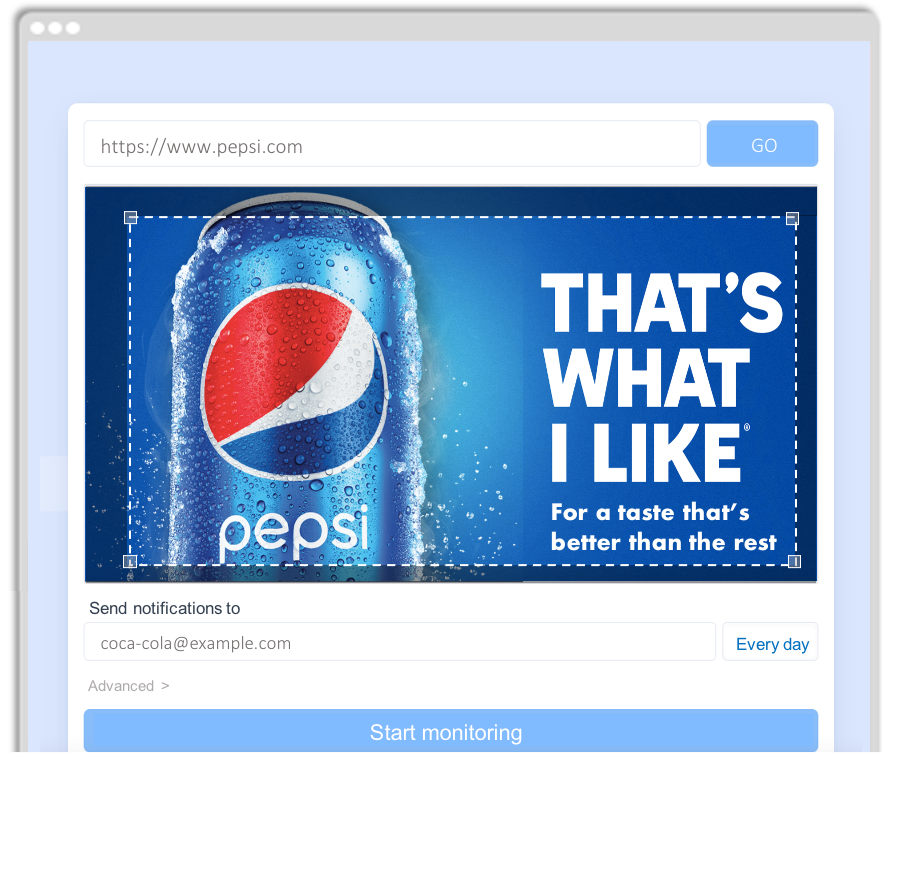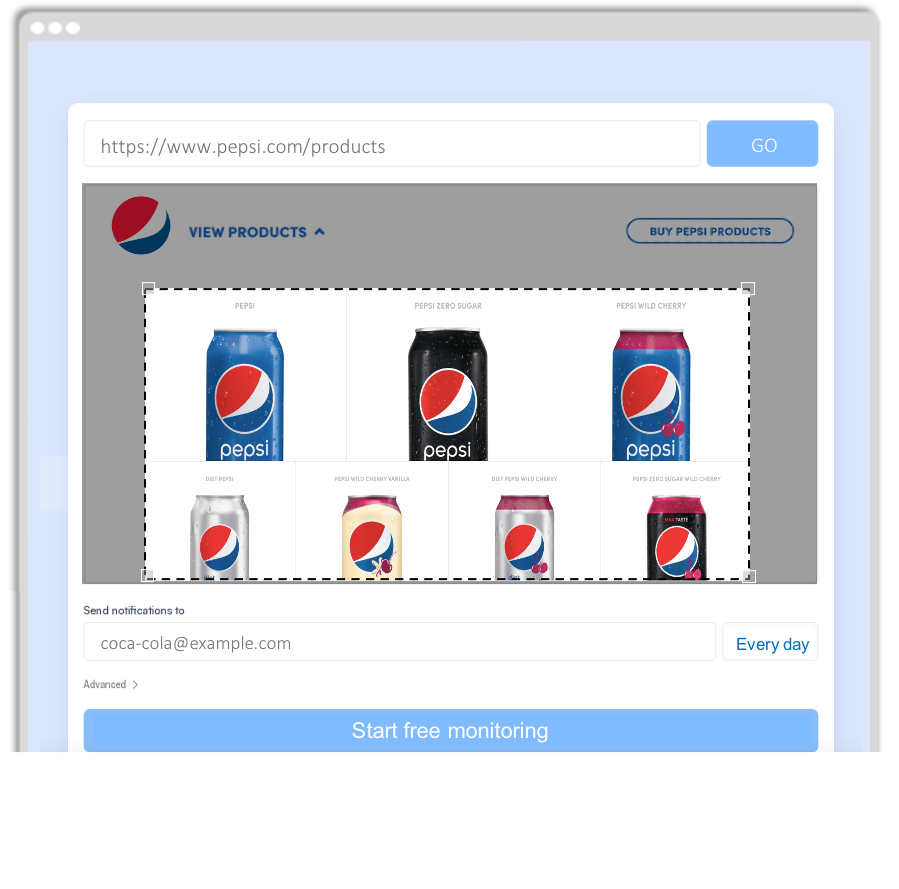How to Track Competitors' Websites for Changes
By Emily Fenton
Updated October 12, 2024

Long gone are the days of manually checking competitors' websites for meaningful updates.
With Visualping, automatically monitor competitor websites, and get notified of changes with AI-generated summaries.
Introduction
Nowadays, it’s standard to use software to spy on competitors.
Famous rivals do it all the time. Uber’s “secret software” used technology to guess how many Lyft drivers were available and where, so they could offer faster pick-up times. Amazon gouged data from its sellers to launch its own competing private-label products.
With fierce competition comes executives, marketers, product developers and account managers needing to keep an eye on the competitive landscape on an ongoing basis. This is to keep their competitive intelligence up-to-date, to know how to build, market and sell a product strategically.
And one of the best places to monitor for competitive intelligence is your competitors' websites, which you can do with Visualping.
In this post, we'll cover why you should track competitor websites, why you should use automated competitor monitoring tools to do so, and how to get set up with your own, so you can get started tracking competitors' websites today.
Why Monitor Competitor Websites for Changes?
Competitor websites have become a key source of competitive intelligence data. Crayon’s 2020 competitive intelligence report, which sampled 1,000 executives of small, mid-sized and large businesses, said 98% of businesses rated competitor websites as the top source of competitive intelligence data.
Websites can tell you a lot about how a business understands their target audience, upcoming plans, new marketing strategies, new product releases and promotions.
Website Homepage and Sitemap
Websites are rich with product marketing messages – the problems customers face, and how their product and services ease these pain points. Insights about the stories your competitors tell about their business, and the way they tell them, can help you make decisions about how you want to tell your own story on your website.
When changing things like their design layouts, main headers, design aesthetic and web elements, this is an indication that your competitor is testing new marketing strategies, and ways to pull prospective users through their sales funnel. Get pointers from your competitors by keeping an eye on these website changes.
Monitoring their website sitemaps is also an efficient way of keeping tabs on updates to your competitor's website -- in a snapshot, you can see the latest website changes they're making.
If a company restructures their navigation or adjusts their value proposition statements, this can also be a sign something new is being prepared – such as a product or initiative being released.
Staying up to date with how your competitors tell their story on their website – even just the subtle changes – is pivotal to anticipating their next moves and maintaining your own relevance in the market.

Products and Features
Another way to keep tabs on your competitors is to track changes to product pages. You can stay up to date on their newest releases, and the latest features they're rolling out – size color, size and functionality.

By tracking the product pages, you can also get marketing insights into how your competitors articulate the value of these products – through their product descriptions, and how the products are organized into bundles.
Visualping is a website monitoring tool that's commonly used to monitor competitor websites for changes. Visualping sends you automatic notifications when a page from your competitor's website changes, helping you stay in the know more easily and efficiently.
Prices and Promotions
Competitor price tracking is another benefit of monitoring your competitor's website for changes.
Pick up on pricing patterns to help you understand their strategies and inform your own pricing strategy.
You can also keep an eye out for their latest promotions, so you can strategize accordingly and consider taking action with your own promotions to stay relevant..
News and Press Releases
Tracking your competitors’ newest headlines and press releases from their website can give you plenty of clues to their future plans. By tracking competitor successes, you can also see if you can benefit from their publicity. Many businesses have a news and press releases page on their website that you can track, and in which they update regularly.
But beyond competitor websites, competitive tracking tools can also monitor new headlines in external news publications – that’s positive and negative publicity, and everything in between. Competitors’ public missteps can be turned into key insights for your own business to avoid potential losses in the future, and to know when to leverage your products and services advantageously.
Customer Reviews
Competitors’ customer reviews offer a way for you to view your competitors through their customers’ eyes; you can see where your competition is checking the boxes, and where they’re underperforming. You can watch how they respond to feedback for clues into your own customer service strategy.
Social Media
Many businesses turn to social media to build brand awareness and establish authority in their industry. Many businesses post new content weekly, if not daily. By tracking changes to their profile and new posts, you can gather more insights into how they position themselves in the market, and source some creative inspiration from their content ideas.
Many businesses also post their future plans on social media – new partnerships, upcoming products and promotions. Monitor their social media to get a strong understanding of their branding strategy, and always have a sense of what’s coming next.
Why Use Website Change Monitoring Tools?
Website change monitoring tools make the competitor research process more efficient, because you can monitor more information, at scale, with less effort and time.
They're also optimal for tracking specific competitor updates, because you can select any web page, on the internet, to track - whether that be changes to competitors products, pricing, content, news, funding, PR and team, or whatever else. In which case, Visualping is the top option.
Visualping, is an AI-powered website monitoring tool that lets you automatically get notified of changes from any web page on the internet. You can track the exact competitor moves that matter to you - without manually checking these pages yourself.
The alerts include an AI summaries of the page change, distilled in 2-3 lines, so you can understand the update quickly. The alerts also include a screenshot of the change, the changes highlighted, for you to see.
Save time with Automation
Competitor monitoring tools automate the process of checking web pages for changes, so you can save time. At the frequency you specifify, the tool automatically checks pages for changes for you, sparing you from the manual work yourself.
Detect Competitor Updates at Speed and Scale
Visualping offers real-time monitoring options, so you can become aware of updates within 5 minutes of them occuring.
Monitor Exactly What Matters
With Visualping, you can choose which page on the internet to track, and also which parts of the page you want to monitor.
To only get alerted of exactly what matters to you and your team, you can apply custom monitoring filters -- to only get notified whether certain keywords or phrases are added or removed from a page, for example. You can also adjust the level of change that triggers alerts.
Easily Understand the Changes
After gathering the highlighted web page pages in your user dashboard, use Visualping to generate advanced custom reports to review many web pages at once, in a glance. Analyze many updates over time in a single glance, to generate insights and adapt to changes in your industry or market.
How to Monitor a Competitor's Website for Changes
Get AI-Powered Change Alerts with Visualping
To compete strategically, you should track competitors on a regular basis and use your findings to foster competitive intelligence for informed business decisions.
But manually tracking these sources of data for changes is tedious and time-consuming. Not to mention, over time, important competitor updates are bound to slip through the cracks and go unnoticed.
Instead of manually checking these sources of data for changes, you can use competitive tracking tools like Visualping to automatically track changes for you.

When a change is detected on the page, Visualping sends you an email alert. Attached is a screenshot of the page with all the highlighted changes, and a link to your dashboard where you can view all the content changes over time.
By setting up automatic email alerts for various competitor pages you’re interested in – their homepage, product and pricing pages, press release pages and social media – you can streamline the process of watching these updates unfold.
You’ll be the first to know about new developments on your competitors’ websites – and without the hassle of manually checking the pages and scanning them for changes yourself.
Visualping also stores screenshots of web page changes, so you can see how the changes take place on the page over time. Track the evolution of colors, positioning of elements, special offers, banner ads and marketing statements.
Alerts act as catalysts for your team to explore what your competition has introduced. And maintaining this archive of change data over time can help embed visual data collection into the DNA of your organization, and provide an essential tool for decision-making.
Conclusion
Staying on top of new data from your competitors’ websites and other activities online can make a big difference in your own strategy. Implementing powerful, automated web page monitoring can have a significant impact on your business.
Make use of competitive intelligence tools like Visualping to easily monitor website changes for you and integrate these insights into your team’s competitive strategy so you can rise above the competition.
Want to find out more about how Visualping can help support your competitive tracking strategy? Reach out to our team -- We'd be happy to help.
Visualping: competitor monitoring made simple
Get targeted updates from the competition on autopilot. Trusted by 85% of Fortune 500 companies.
Emily Fenton
Emily is the Product Marketing Manager at Visualping. She has a degree in English Literature and a Masters in Management. When she’s not researching and writing about all things Visualping, she loves exploring new restaurants, playing guitar and petting her cats.
